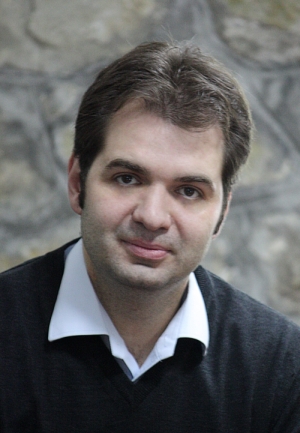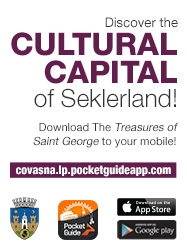Székely Nemzeti Museum
www.sznm.ro
The Székely Nemzeti Museum is open to the public since 1875. This significant academic institution undertook the research and presentation of the Sekler and Transylvanian regions heritage.
At the moment this is the largest collection in Transylvania. The building complex currently gives place to a library, a natural sciences department, a history and archeology department and an ethnography department. The largest mushroom collection in Romania can be viewed here, as well as more than 23,000 pieces of the Diószeghy László`s butterfly collection.
Excluding the internal departments of the institutions, other departments also belong to them, such as the gallery of Sfântu Gheorghe (in Hungarian: Sepsiszentgyörgy) (the Gyárfás Jenő Gallery provide professional warehouse and exhibition space to the 19-20. century paintings, sculptures and graphic works), and the external units of the museums of Kézdivásárhely, Csernáton, Barót and Zabola.
Háromszék Dance Ensemble
www.hte.ro
Collecting, preserving, sharing and presenting the artistic value of the Transylvanian folk music and folk dance culture are the main objective of the Háromszék Dance Ensemble. The ensemble is not only promoting the Hungarian dances by theatrical performances, but also by taking the dances among the people, to the crowd. From the 2001-2002`s season the Háromszék Dance Ensemble in cooperation with the Lajtha László Foundation and the Kónya Ádám Cultural House revived the Sfântu Gheorghe (in Hungarian: Sepsiszentgyörgy) dance club. The Városi Cultural House`s hall gives place to it.
The basic idea is similar to the Kommandó Cigányfolklór Camp. The annual event was born with the aim to provide an insight into the lives of the gypsy`s culture and everyday life.
Tamási Áron Theatre
www.tamasitheatre.ro
The theatre of Sfântu Gheorghe (in Hungarian: Sepsiszentgyörgy) was established in 1948 as a professional art institution named as Állami Magyar Theatre. Since 1998 its name is Tamási Áron Theatre. The theatrical pieces, such as Ödön von Horváth: Kasimir és Karoline, Euripides: Alcestis, Witkiewicz: Vízityúk, a Vérnász, Tadeusz Slobodzianek: Ilja próféta, William Shakespeare`s Romeo and Juliet, Tamási Áron: Vitéz lélek és Énekes madár directed by Bocsárdi László or Barabás Olga Moliére pieces, the Don Juan, and the Scapin furfangjai, later the Peer Gynt-átirata and Partok szirtek hullámok piece lead the Sepsiszentgyörgyi Tamási Áron Theatre to the Transylvanian theatre`s forefront. In 2012 the Reflex International Theatre Biennale was organized the second time, which event collects Central Europe`s different national cultures theatrical pieces and wants to present them as one theatrical event, and also wishes to set in a parallel with the major Western theater cultures groundbreaking performances. The guest performers were invited from Germany, Italy, Poland, Lithuania, Hungary and Romania.
M Studio
www.m-studio.ro
The M Studio was founded in 2005 in Sfântu Gheorghe(in Hungarian: Sepsiszentgyörgy). It was initially created to be the Háromszék Dance Ensemble movement theatre as an experiment, that stretches the boundaries of the traditional theatres toolbox and presents a new creative and innovative dance theatre.
Major pieces: Molnár Ferenc: Liliom, William Shakespeare: Romeo and Juliet, Adagio Cantabile, Éden, Mint a fagyöngy, William Shakespeare: Hamlet...
Covasna County Cultural Center
www.kultkov.ro
The Covasna County Cultural Center is exploring, promoting and documenting the historical Three Chairs region`s (Háromszék) cultural events, traditions and customs. Their activity consist of research, training and publishing, and also organizing and supporting the county, regional and international festivals, exhibitions, camps, traditional events, scientific symposia and seminars. For the effectiveness of these events promotions, from 2005 they started to give each year a theme, so year by year the events are thematic, annually highlighting specialties and crafts such as Ünnepi Népszokások Éve – 2005, Ifjúság Éve – 2006, Találkozások Éve – 2007, Népi Mesterségek Éve – 2008, Benedek Elek Éve – 2009, Képzőművészetek Éve – 2010.
Kónya Ádám Cultural House
www.kultur.ro
The community center is primarily intends to be the home of the city's culture-loving and artistic people, a place where various public and private initiatives and ideas can be realized. Its purpose is to support the art-loving amateur individuals and groups. Social and educational programs are created in order to help people who wish to get closer to their roots, and also people who want to get an insight into our culture and traditions. The institution is initiating a lot of events with cultural values and supports a diverse and tolerant world that helps build Sfântu Gheorghe (in Hungarian: Sepsiszentgyörgy).
Main activities: choir, theatre, dance, visual art, crafts, music, clubs (jazz, news, movies…).
Bod Péter County Library
www.kmkt.ro
The institution mainly collects Hungarian and Romanian language documents. As a real community library the purpose of their activities and projects is to create a place where the user can gain information and find communication services in the widest range of topics, beside the traditional library services. Its meaningful and pleasant cultural events serve to retain and attract new and existing audience. At the end of 2012, they had 219,128 documents in stock (books, magazines, audiovisual documents).
The Bod Péter County Library beside the fact that offers the opportunity of renting and reading in its reading room, they also pay special attention to children. At school time twice a week they are waiting the children for fairy tale afternoons, and other days they offer children-care for one or two hours.
MAGMA Contemporary Art Space
www.magma.maybe.ro
Magma is acting in two directions. On the one hand, it is boiling, forming under the surface, on the other hand, it comes to the surface from time to time, erupting. Niklas Luhman’s description of autopoetic may be considered as valid as the (self)-definition of being a collective action. Magma is autopoetic in the sense that it perpetually sustains, resuscitates itself, without considering any kind of formal or thematic restriction. Paradoxically, however, it cannot be perceived as a circular gesture, originating from and returning to itself. It is rather a collective manifestation of a self-functioning unit. In the following we offer a presentation of consecutive eruptions, which trace the movement of Magma, led by Ágnes Evelin Kispál, Barnabás Vetró and Attila Kispál.
Andrei Mureşanu Theatre
www.tam.ro
The Andrei Mureşanu Theatre is a public institution providing fun and joy, and the main organizer of cultural events in the area for the Romanian minority. From 1992 the theatre separated itself from the Tamási Áron Theatre. Despite the fact that the two institutions still use the same building, from 1992 they are two independent institutions, they operate with their own team, and with different cultural strategy.
The Andrei Muresanu Theatre offers the audience classic and universal Romanian literary assemblies and contemporary pieces, and the team is open to the theatrical performances that are currently in trend (dance performances, visual theater, performance LEDs, happenings, workshops, etc.). The theatre was invited in 2010 to the Varna Summer International Theatre Festival, in Bulgaria, where they performed the “Lucia skates” piece, directed by Radu Afrim.
Outstanding performances: Cameristele, Ţara Clownilor, Fata babei şi fata moşneagului, Mai întâi te naşti, Casanova, Îngerul şi floarea, Poveşti de familie...
Árkosi Cultural Center
www.ccarcus.ro
The Árkosi Cultural Center is a cultural institution, which operates under the subordination of the Ministry of Culture and Religious Affairs.
The activities of the Árkosi Cultural Center:
• Organizing their own and also different partner institution`s performances in various cultural and artistic fields.
• Meeting place for various cultural relations
• Cultural performances, public meetings, meetings, symposia, workshops and artistic circles, organizing thematic cycles of lectures and concerts
Lábas Ház (Arcade House)
The Sfântu Gheorghe (in Hungarian: Sepsiszentgyörgy) Lábas Ház gives place to various civil institutions, and to the city tourist information office, the Tourinfo. Beside the office space, the building has two exhibition halls, where the Romanian Artists Association organizes periodic exhibitions. In the basement of the Lábas Ház a multimedia city history exhibition welcomes the visitors, where the town`s history, and its rich cultural past opens up to the visitors in a unique, unexpected way with the help of the multimedia.
Organizations and institutions:
• Alpine Sport Club www.alpinsport.ro
• Nyugdíjasok Sugás Szövetsége
• Tourinfo- Tourism and Information Office
• Citizens Advice Bureau
• A Fotóművészetet Pártoló Gyulai Ferenc Egyesület - www.fotogyulai.ro
• Etna Alapítvány - www.actio-ts.ro
• Hárit - www.harit.ro
• EMI (Erdélyi Magyar Ifjak) – Turulmadár Iroda - www.emihirek.ro
• Mihai Viteazul Szövetség
• Youth Resource Center
Keleti Kárpátok Museum
www.mncr.ro
In 1995, the National History Museum of Transylvania created an archeology department in Sfântu Gheorghe (in Hungarian: Sepsiszentgyörgy), which in 1999 under the 1365/1996 decree became a separate museum, named as the Museum of Eastern Carpathians (in Hungarian: Keleti Kárpátok Múzeuma) and operates as the subordination of the Ministry of Culture. In 2007, the institution has received the „National” title, and therefore the institutions name at the present is the National Museum of the Eastern Carpathians (Keleti Kárpátok Nemzeti Múzeuma) as the subordination of the Ministry of Culture and National Heritage.
Since 1999, the institution undertook the local and East Carpathian heritages presentation and preservation. The museums historic, archaeological and ethnographic collection has now over 16,000 items. Over the years, the researches were focused on saving and preserving the material heritage, but now they are focusing more on researching and conserving the endangered immaterial heritage. The museum has organised a lot of research and exhibition, individually and with the assistance of Romanian and foreign institutions. The most important archeological researches were held in Covasna, Dák Tündérvár, Oltszem, Homokbánya, Csík-Csomortán Pálfalva, Várdomb and Bistrita. The ethnographic researches took place at Covasna, Brasov, Harghita, Bistrita and Bacau counties.

